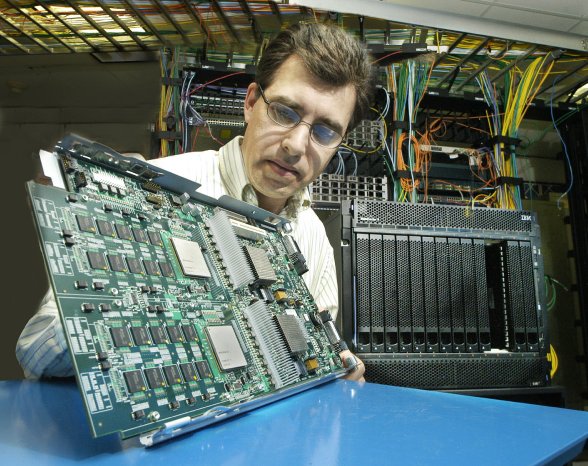The IBM BladeCenter QS20 is a Cell BE-based blade system designed for businesses that can benefit from high performance computing power and the unique capabilities of the Cell BE processor to run graphic-intensive applications. The IBM BladeCenter QS20 will expand the use of Cell into industries such as medical imaging, aerospace, defense, digital animation, communications and oil and gas – with the ability to dramatically transform those industries.
Based on the Power Architecture, the Cell BE was originally developed by IBM, Sony and Toshiba for use in gaming consoles. Cell BE’s breakthrough multi-core architecture and ultra high-speed communications capabilities deliver vastly improved, real-time response effectively delivering 'supercomputer-like performance' by incorporating IBM’s advanced multi-processing technologies usually reserved for the company’s most sophisticated servers.
Beta versions of the IBM BladeCenter QS20 are already in use at customer sites across the U.S., as well as in the United Kingdom, Spain, Germany, France, Japan and Korea.
Early deployments include the University of Manchester, the United Kingdom's largest single-site university, which boasts a research computing division that is among the world leaders – with the goal to provide world class, leading high performance computational facilities to staff and students at the University. “We are early adopters of the IBM BladeCenter QS20 because it has the potential to give us significantly improved performance, take up less space, and consume less power,” said W. T. Hewitt, Director of Research Computing, University of Manchester. “High performance computing systems built from blade systems based on the Cell Broadband Engine have the potential to change the economics associated with supercomputing, and thus we are looking at migrating the range of our scientific applications including bio-informatics, molecular modeling and engineering applications onto the systems to dramatically improve their performance, at the same time as reducing our costs.”
Another early adopter is RapidMind, Inc., a Waterloo, Canada-based development platform company which enables software developers to quickly and effectively take advantage of a new generation of high performance processors. "The IBM BladeCenter QS20 offers our customers the opportunity to continue to use the simplicity of the RapidMind Development Platform while leveraging the performance of the Cell Broadband Engine,” said Ray DePaul, President & CEO of RapidMind Inc. “Application vendors are eager to adopt new innovations that drive performance benefits and the new Cell-based system from IBM is proving to be extremely effective at workloads such as image processing."
Fraunhofer Institute for Industrial Mathematics is a German-based research institution, specializing in providing high performance computing research results in mathematics, material research, mechanical engineering to industries across the globe. "We are using IBM's new BladeCenter QS20 as an ideal platform to develop software for emerging multicore system, and dramatically improve our own in house visualization applications," said Dr. Franz-Josef Pfreundt, Head of the Competence Center for HPC and Visualization, Fraunhofer Institute for Industrial Mathematics. "The powerful development environment allows for our Institute to run mathematical, medical visualization and GraPA based in-house applications at lightning-fast speed, processing millions of pieces of data in just seconds- allowing us to process, interpret and deliver research results faster."
The IBM BladeCenter QS20 system will rely on the Cell BE processor to accelerate computationally intense workloads associated other specific industry needs, such as 3D animation rendering, compression, and encryption, and seismic and medical imaging to help companies create and run highly visual, immersive, real-time applications.
Specific examples include:
· Medical industry: The IBM BladeCenter QS20 can dramatically reduce the time it takes for physicians to compare and map 3D medical images, which typically are taken over months or years with different resolutions and different devices. Running the medical image application on the QS20 can enable physicians to map multiple images in seconds compared to minutes – improving accuracy, reducing diagnosis time, and saving patient anxiety.
· Aerospace & defense industry: Signal processing and radar results in the aerospace industry is based on combining analysis, location and terrain with speed and accuracy. Radar application and solutions running on the IBM BladeCenter QS20 will result in a higher fidelity and higher resolution of radar output, which means operators will be able to see objects and information never previously captured through current radar systems.
· Oil and gas industry: New innovations in seismic imaging are allowing energy companies to locate and drill for oil more accurately and in less time - which can dramatically improve the profitability of new drilling operations. These compute intensive applications – ideal for IBM BladeCenter Q220 – can also be used to reduce current deep sea drilling “miss” rates, potentially saving millions in unnecessary costs for drilling operations.
The combination of IBM's BladeCenter system with the Cell BE processor is an example of IBM's continued collaboration with clients to help them create breakthrough solutions using IBM technology and expertise. Last year, IBM announced it is collaborating with Mercury Computer Systems to enable them to build Cell BE-based solutions targeted at multiple industries. IBM will also continue to work with the broader community through Blade.org, Power.org and open standards to bring additional Cell BE-based solutions to market.
According to industry data, IBM is the number one blade server vendor in the world in both revenue share and blade server shipments, having shipped over half a million systems since the IBM BladeCenter inception in 2002. The IBM BladeCenter QS20 based on Cell BE will be delivered via IBM's System Cluster 1350. The System Cluster 1350 has established a remarkable reputation in the High Performance Computing community as the flagship Linux cluster offering from IBM and is featured prominently in the latest Top 500 Supercomputers listings. The System Cluster 1350 from IBM offers a wide variety of server, processor, and switching technology choices and is completely warranted by IBM as a single support source. For more information on the IBM BladeCenter QS20, log on to http://www-03.ibm.com/....

